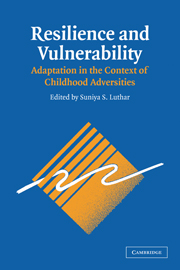Book contents
- Frontmatter
- Contents
- List of Contributors
- Foreword by Dante Cicchetti
- Preface
- 1 A Resilience Framework for Research, Policy, and Practice
- PART I FAMILIAL ADVERSITIES: PARENTAL PSYCHOPATHOLOGY AND FAMILY PROCESSES
- PART II EXOSYSTEMIC AND SOCIODEMOGRAPHIC RISKS
- 10 Rethinking Resilience: A Developmental Process Perspective
- 11 Poverty and Early Childhood Adjustment
- 12 Emerging Perspectives on Context Specificity of Children's Adaptation and Resilience: Evidence from a Decade of Research with Urban Children in Adversity
- 13 Holistic Contextual Perspectives on Risk, Protection, and Competence among Low-Income Urban Adolescents
- 14 Overcoming the Odds? Adolescent Development in the Context of Urban Poverty
- 15 Adaptation among Youth Facing Multiple Risks: Prospective Research Findings
- 16 Positive Adaptation among Youth Exposed to Community Violence
- 17 Perceived Discrimination and Resilience
- 18 Promoting Resilience through Early Childhood Intervention
- PART III COMMENTARIES
- Index
- References
14 - Overcoming the Odds? Adolescent Development in the Context of Urban Poverty
Adolescent Development in the Context of Urban Poverty
Published online by Cambridge University Press: 05 June 2012
- Frontmatter
- Contents
- List of Contributors
- Foreword by Dante Cicchetti
- Preface
- 1 A Resilience Framework for Research, Policy, and Practice
- PART I FAMILIAL ADVERSITIES: PARENTAL PSYCHOPATHOLOGY AND FAMILY PROCESSES
- PART II EXOSYSTEMIC AND SOCIODEMOGRAPHIC RISKS
- 10 Rethinking Resilience: A Developmental Process Perspective
- 11 Poverty and Early Childhood Adjustment
- 12 Emerging Perspectives on Context Specificity of Children's Adaptation and Resilience: Evidence from a Decade of Research with Urban Children in Adversity
- 13 Holistic Contextual Perspectives on Risk, Protection, and Competence among Low-Income Urban Adolescents
- 14 Overcoming the Odds? Adolescent Development in the Context of Urban Poverty
- 15 Adaptation among Youth Facing Multiple Risks: Prospective Research Findings
- 16 Positive Adaptation among Youth Exposed to Community Violence
- 17 Perceived Discrimination and Resilience
- 18 Promoting Resilience through Early Childhood Intervention
- PART III COMMENTARIES
- Index
- References
Summary
Adolescence, a time of rapid biological, emotional, and social changes, brings with it a heightened developmental risk (McCord, 1997). This risk may be highest for adolescents growing up in poverty within our country's inner cities. In addition to the normative stress of adolescence, poor inner-city youth face multiple stressors and adversities including crowded housing, poor-quality schools, inadequate nutrition, and the presence of violence and drugs in their neighborhoods (Sampson, Morenoff, & Earls, 1999). These factors, in turn, have been linked to a host of negative outcomes (Brooks-Gunn & Duncan, 1997; Gorman-Smith & Tolan, this volume). Nonetheless, some inner-city youth survive these circumstances, overcoming adversity to become productive members of society. This chapter will highlight research that helps us understand the dynamic process of risk and resilience during this difficult transition in an even more difficult context.
We begin this chapter with a definition of adolescence and urban poverty and then lay out a rationale for focusing on two outcomes, school achievement and dropout and behavior problems of an internalizing or externalizing nature. We then identify salient factors that increase vulnerability or protective processes for youth growing up in urban poverty. We end with a discussion of resilience, emphasizing the limits of resilient adaptation and implications of this for theory and research on resilience, as well as for interventions that may better the lives of these vulnerable youth.
- Type
- Chapter
- Information
- Resilience and VulnerabilityAdaptation in the Context of Childhood Adversities, pp. 343 - 363Publisher: Cambridge University PressPrint publication year: 2003
References
- 46
- Cited by



